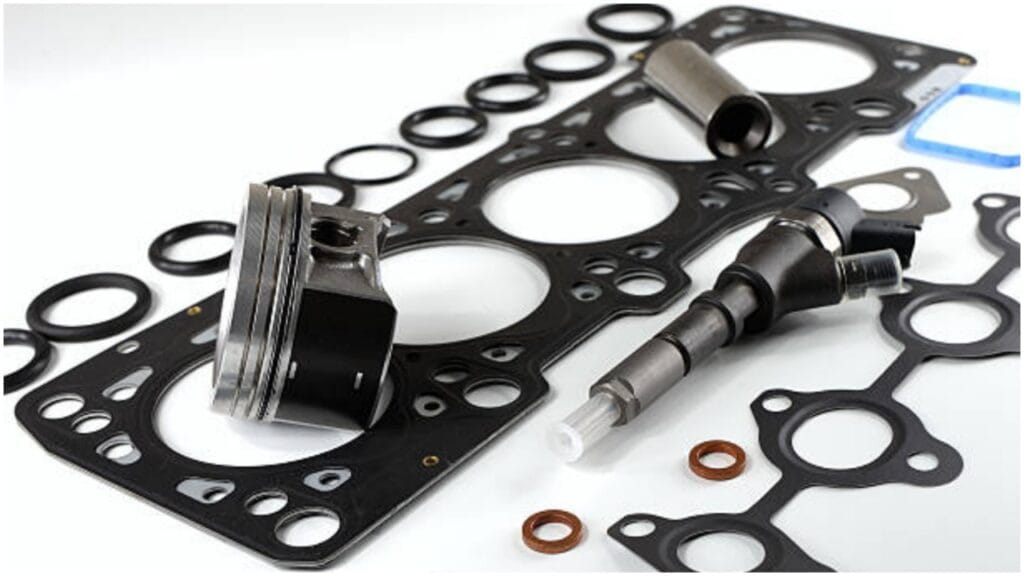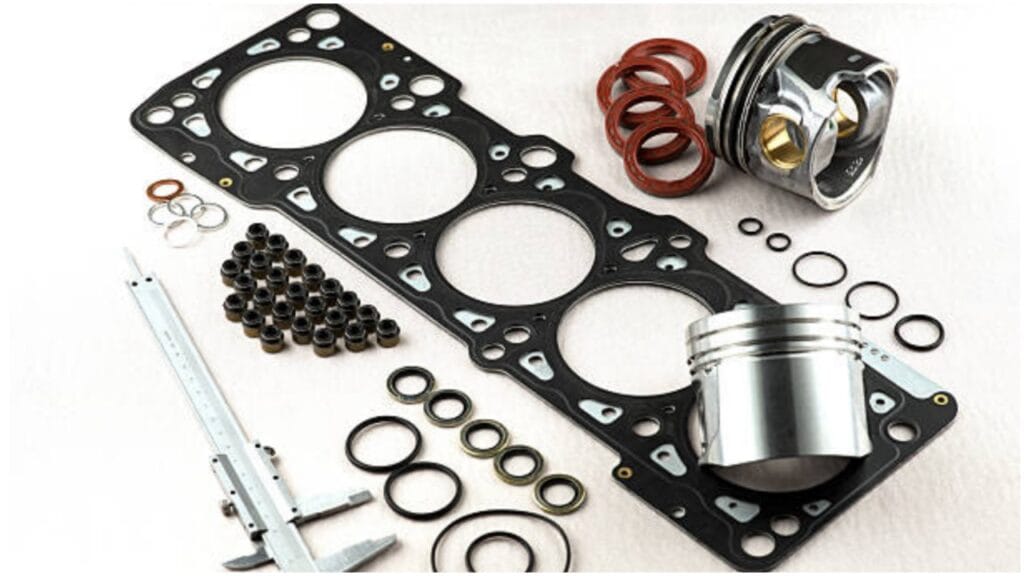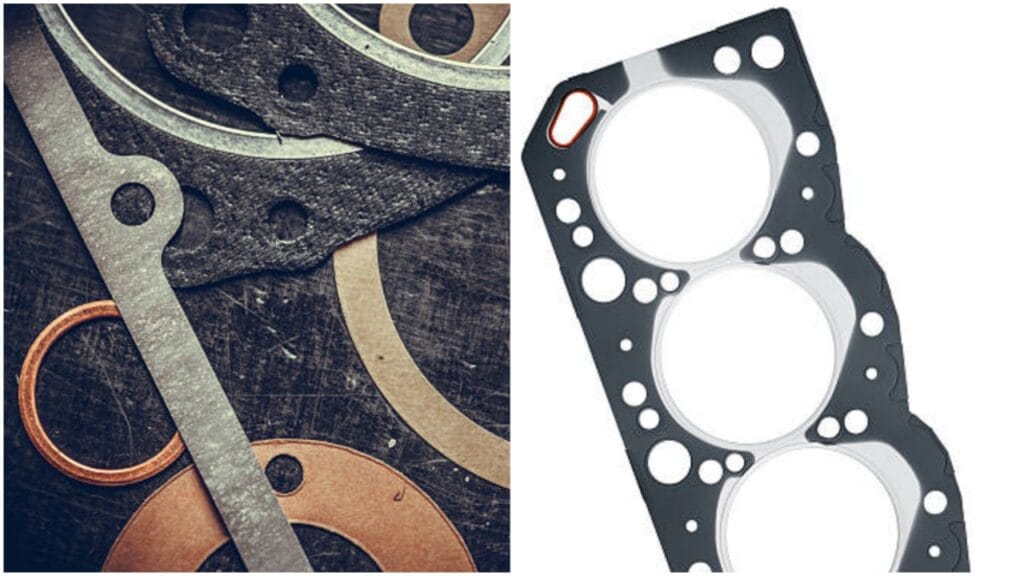The cylinder head gasket seals the engine block to the cylinder head, withstands intense combustion pressures, and isolates oil and coolant. In contrast, the valve cover gasket seals the valve cover to the cylinder head, preventing oil leakage from the valve train area.
Want to know how to spot the signs of gasket failure, understand the repair process, and how to prevent these problems? Keep reading to learn more about these essential engine components, hopefully giving you a better idea.
First, let’s start very simply, without getting too complicated, so that you can understand what these are and what they can be.
What Is a Cylinder Head Gasket?
The cylinder head gasket is a specialized engine component, a critical seal sandwiched between the engine block and the cylinder head. Its main job? To maintain an airtight barrier, withstanding the intense combustion pressures and preventing the mixing of vital fluids, oil and coolant.
The robust design of this gasket is essential for optimal engine performance; it has to withstand extreme heat and pressure fluctuations. More than just a seal, it is a protector, ensuring the engine operates efficiently by maintaining compression and preventing catastrophic fluid contamination. In short, it is the guardian of the engine’s core.
What Is a Valve Cover Gasket?
This is also an engine component, where all the valves are moving at high speed, which requires constant oiling. This part, covered by the “valve cover,” is like a well-lubricated machine. To keep the oil in and prevent it from leaking out, a valve cover gasket is used. It is a seal, usually made of rubber, cork, or similar material, that sits between the valve cover and the engine.
Think of it as a tightly fitting ring that stops the oil from leaking out when the engine is running. Without it, oil will leak, potentially damaging the engine. So, the valve cover gasket is a crucial part, ensuring that the oil stays where it needs to be so that your engine can run smoothly.
How do head gasket and valve cover gasket work?
The cylinder head gasket works in the most demanding environment of the engine. Its primary function is to control the explosive force generated within the cylinder, so that the energy is effectively transferred to the piston.
At the same time, it acts as a barrier, preventing the mixing of two fluids essential to the health of the engine: coolant and oil. This dual role requires a robust design, capable of withstanding extreme conditions and maintaining integrity under pressure.
In contrast, the valve cover gasket serves a less rigorous, but equally important, purpose. Located at the top of the engine, it seals the valve cover to the cylinder head, preventing oil from escaping from the valve train area.
This area contains moving parts that require constant lubrication, and the gasket ensures that the oil is contained. Unlike the head gasket, which is exposed to high pressures, the valve cover gasket primarily prevents oil from leaking. Its function is to create a simple, effective seal, ensuring that the engine remains clean and properly lubricated.
Understanding Gaskets in Your Engine

Think of gaskets for your engine as rubber bands. You have two main gaskets. The head gasket? It’s tough. It’s deep inside, where things get hot. It stops fire and water from mixing.
It’s a big job! Then, there’s the valve cover gasket. That’s on top. It just stops the oil from leaking out. And the other one keeps the oil in. Every place where two parts of your engine meet, there’s probably a seal making sure nothing leaks or escapes. That’s the gasket.
Definition and Function of Cylinder Head Gasket
The cylinder head gasket is a critical seal located between the engine block and the head. It is designed to withstand extreme pressure and heat, preventing combustion gases from escaping. Its job is to keep the engine’s coolant and oil separate, even though they travel through shared paths.
This separation is essential; mixing these fluids can cause serious engine problems. Made of tough materials, it is designed to withstand high pressures. When this gasket fails, expect overheating, white exhaust smoke, or the appearance of white oil. It is a key component that ensures the engine operates efficiently and safely.
Seals Combustion Gases
Combustion happens inside the engine. The head gasket is a barrier. It stops hot gases from escaping. These gases push the engine’s parts. The gasket keeps them inside. Without it, the engine loses power. It’s a tight seal. It handles very high heat. It keeps the engine working.
Prevents Fluid Leaks
The head gasket stops fluids from leaking where the engine’s head and block meet. Coolant and oil flow through this area. The gasket keeps them separate. It’s designed to make a tight seal. Without it, fluids mix or leak out. This leads to engine damage. The gasket is essential for keeping fluids where they belong.
Maintains Engine Compression:
Engine compression is key for power. The head gasket seals the cylinders. This seal keeps the air and fuel mix inside. When the mix burns, it pushes the pistons. A good seal means strong pushes. A bad seal means weak pushes. The engine loses power. The gasket makes sure the engine works well.
Definition and Function of Valve Cover Gasket
The valve cover gasket is a seal. It sits between the valve cover and the engine’s head. Its job? To stop oil from leaking. Oil keeps the engine’s top parts moving smoothly.
The gasket makes a tight seal. It doesn’t deal with fire or big pressure. Just oil. If it breaks, oil spills. This makes a mess and wastes oil. It’s a simple part, but vital.
Oil Sealing
The valve cover gasket’s core function is oil sealing. It creates a barrier, preventing oil from escaping the engine’s top section. This area, the valve train, needs constant oil for smooth operation.
The gasket ensures this oil stays contained. Without it, oil leaks lead to a messy engine and potential damage. It’s a simple seal, but crucial for keeping oil where it belongs.
Protection
The valve cover gasket protects. It keeps dirt out. It stops oil leaks. Dirt can hurt the engine. Oil leaks make a mess. The gasket makes a seal. It keeps things clean. It helps the engine run right. It’s a small part. It does a big job.
Vibration Damping
The valve cover gasket also plays a role in vibration damping. Engine vibrations can loosen parts. The gasket, often made of flexible material, absorbs some of these vibrations. This helps maintain a tight seal and prevents leaks.
Signs of Failure
A failing head gasket often triggers overheating and white exhaust smoke, signaling coolant issues. Valve cover gasket leaks cause oil drips and a burning smell, pointing to a breakdown in the top engine seal. Both failures result in performance decline, but head gasket issues pose a greater risk.
Common Signs for Cylinder Head Gasket Failure
There are several main symptoms of cylinder head gasket failure. An early indicator is engine overheating, often accompanied by white smoke from the exhaust, which is caused by coolant burning in the combustion chamber. A clear sign is the presence of white oil, which indicates coolant mixing with engine oil.
Loss of engine compression, resulting in reduced power, also indicates head gasket failure. These symptoms collectively indicate a serious crack in the seal between the engine block and cylinder head, which requires immediate attention.
Common Signs for Valve Cover Gasket Failure
Valve cover gasket failure typically manifests through noticeable oil leaks. You’ll often see oil accumulating around the valve cover’s edges, potentially dripping onto hot engine components, leading to a distinct burning smell.
Consistently low oil levels, requiring frequent top-ups, also point to a compromised valve cover gasket. These signs indicate a breakdown in the seal, allowing oil to escape the valve train area. While less critical than a head gasket failure, these leaks can still lead to a messy engine and potential oil-related issues.
Consequences of Gasket Failure

Head gasket failure leads to overheating, fluid mixing, and power loss, risking severe engine damage. Valve cover gasket leaks cause oil spills, burning smells, and low oil levels, resulting in a messy engine and potential fire hazard.
Effects of a Failed Cylinder Head Gasket
A failed head gasket causes overheating and white smoke, which is an indication of a coolant problem. White oil contaminates the engine. Compression loss impairs performance. In severe cases, the engine is likely to seize.
This failure can result in major damage, requiring expensive repairs or replacement. A breach in the gasket compromises the integrity of the engine, leading to significant problems.
Effects of a Failed Valve Cover Gasket
A leaking valve cover gasket means oil spills. Hot engine parts get soaked with dripping oil, creating a distinct burning smell and a fire hazard. You’ll be constantly adding oil.
This can damage other engine parts over time. While not as catastrophic as a blown head gasket, it’s a problem that shouldn’t be ignored. It leads to oil loss and potential secondary problems.
Replacement Costs
Average Costs for Cylinder Head Gasket Replacement
Replacing a cylinder head gasket is a significant financial commitment. The primary cost driver is labor, as this repair involves extensive engine disassembly. While the gasket is relatively inexpensive, additional parts like head bolts, fluids, and potentially machined surfaces of the cylinder head contribute to the overall expense.
The total cost can vary widely, ranging from several hundred to thousands of dollars, depending on vehicle type, engine complexity, and regional labor rates. Due to the complexity of the repair, obtaining multiple quotes from reputable mechanics is strongly advised.
Average Costs for Valve Cover Gasket Replacement
Valve cover gasket replacement is a budget-friendly repair, typically costing between $50 and $250. The gasket itself is inexpensive, often under $30. Labor, if needed, usually runs under an hour, keeping costs down.
DIY is common, saving on labor entirely. Engine layout and accessibility might slightly affect the final price, but it remains a significantly more affordable repair than a head gasket replacement.
Material Quality
Gasket material matters. Quality gaskets last longer. Cheap ones fail fast. Head gaskets need strong materials. Valve cover gaskets need flexible materials. Good materials handle heat and pressure. Choose quality for better engine seals.
Importance of Quality Materials for Cylinder Head Gasket
A quality cylinder head gasket is vital. It faces extreme heat and pressure. Strong materials like multi-layered steel ensure a tight seal. Poor materials fail quickly.
This leads to overheating and engine damage. Quality gaskets handle combustion forces. They prevent fluid mixing. Investing in a good gasket protects the engine.
Importance of Quality Materials for Valve Cover Gasket
Quality materials in a valve cover gasket are crucial for preventing oil leaks. Flexible materials, like silicone or high-grade rubber, ensure a tight seal against the engine’s head. Cheap materials crack or harden, leading to leaks.
A good gasket withstands engine heat and oil exposure. Quality prevents oil spills, keeps the engine clean, and protects surrounding components. It’s a small investment for long-term engine health.
Maintenance and Timing

Regular engine checks prevent gasket failures. Replace gaskets when signs appear. Overheating or oil leaks demand immediate attention. Timely replacements avoid costly engine damage. Follow manufacturer guidelines for maintenance schedules.
When to Replace Cylinder Head Gasket
Replace a cylinder head gasket when you see these signs: engine overheating, white smoke from the exhaust, milky oil, or loss of engine power. These indicate a compromised seal. Don’t delay; prompt replacement prevents severe engine damage. If you suspect a problem, consult a mechanic for diagnosis.
When to Replace Valve Cover Gasket
Replace the valve cover gasket when you notice oil leaks around the valve cover, a burning smell from oil dripping on hot engine parts, or consistently low oil levels. These signs indicate a failing seal. While less critical than a head gasket, prompt replacement prevents messy oil leaks and potential fire hazards.
FAQ
Anyone make their own gaskets?
Crafting gaskets at home is a reality for some, motivated by saving money, adapting to custom builds, or simply finding replacements when none are readily available. Common materials include gasket paper, cork, rubber sheets, and silicone, all shaped with precision using sharp tools and careful tracing.
However, for critical engine components like head gaskets, this practice is strongly discouraged due to the extreme heat and pressure they must withstand. Precision is key; a poorly made gasket can cause serious leaks and engine damage.
Choosing the right material for the job is equally important. While making your gaskets can be a solution for older cars or special projects, it’s essential to consider the risks. For vital engine seals, investing in high-quality, factory-made gaskets is generally the safest and most reliable choice.
Valve train ticking. Valve Shims?
Valve train ticking often signals issues with valve clearance, and in engines using shims, these small discs are frequently the culprit. Over time, wear can alter the clearance between valve stems and rocker arms or camshafts, causing a noticeable ticking sound. While shims are a common cause, other factors like low oil pressure, worn components, or sticking hydraulic lifters can also contribute.
Proper adjustment of valve shims is crucial for engine performance and longevity, as excessive clearance leads to noise and damage, while insufficient clearance can cause power loss. Therefore, when a ticking noise arises, especially in engines with shims, it’s essential to have a mechanic inspect and adjust the valve train.
External head gasket leak?
External head gasket leaks show fluid outside the engine. You see oil or coolant. It leaks where the head meets the block. This happens from a bad gasket. Or, the metal is damaged. Overheating can also cause it. You see puddles under the car.
It’s not as bad as fluid mixing inside. But, it’s still a problem. Coolant loss makes the engine hot. Oil loss hurts the engine. Fix it soon. It can get worse. It might mean a bigger problem inside.
Oil Leak, Smoke But Not Valve Cover Or Head Gasket?
Oil leaks and smoke, but not the head or valve cover? Check these spots. The oil pan gasket can leak. Oil drips on hot parts. Smoke happens. The rear main seal is a common leak. It’s where the engine meets the transmission.
The front main seal can also leak. Oil filter parts can leak too. Turbo oil lines, if you have a turbo, can leak. Oil cooler lines, if your car has one, can leak. A bad PCV valve pushes out oil. Oil pressure sensor can leak. Get a mechanic to check. They will find the leak.
Conclusion
Gaskets, while seemingly simple, are crucial for engine health. Both cylinder head and valve cover gaskets play distinct roles in maintaining engine integrity. Head gaskets handle extreme combustion pressures and temperatures, preventing fluid mixing and compression loss.
Valve cover gaskets primarily prevent oil leaks, protecting the valve train and preventing messy spills. Recognizing the signs of gasket failure—overheating, leaks, smoke, is vital for timely repairs. Quality materials and proper maintenance are essential for gasket longevity.
While DIY gasket making is possible, it’s generally recommended to use high-quality, pre-made gaskets, especially for critical applications. Understanding the functions and potential failures of these components helps ensure optimal engine performance and prevents costly repairs.

